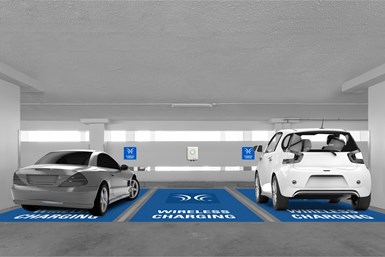WiTricity Lands New Funding
Wireless charging developer targets mainstream applications
#hybrid
Boston-based WiTricity has big plans for its wireless charging technology as demand for electric vehicles begins to accelerate, especially in Europe and Asia.

Wireless charging pad (Image: BMW)
In the last 20 months, the company acquired one of its main rivals—Qualcomm’s Halo business—and launched its first two production applications in the high-end BMW 530e iPerformance sedan and McLaren Speedtail Hyper-GT supercar.
Now WiTricity is taking aim at more mainstream models.
Partnering Up
To support the effort, WiTricity has raised an additional $34 million in funding.
WiTricity plans to use the capital infusion on r&d, expanding its intellectual property portfolio—with the Halo purchase it has more than 1,000 global patents—and commercialization programs.

(Image: WiTricity)
Among the new investors are Mitsubishi Corp.’s Americas operations, Stage 1 Ventures and Air Waves Wireless Electricity. Mitsubishi says its Urban Development Group (UDG) will work with WiTricity on programs for electric and autonomous vehicles in smart cities. Mitsubishi Motors currently offers the Outlander plug-in hybrid in the U.S.
“WiTricity's wireless charging is essential for next-generation infrastructure services that capture the shift to EV and autonomous driving,” says UDG CEO Mitsumasa Icho. “We intend to capitalize on wireless charging, IoT, AI, robots and big data in smart cities.”
Setting Standards
WiTricity also stands to benefit from SAE International’s new J2954 wireless charging standard that was finalized last month.
The protocol, which has been in the works for 13 years, will enable EVs and plug-in hybrid models across most manufacturers to use a common wireless system. J2954 sets criteria for interoperability, electromagnetic compatibility, EMF performance and safety for wireless equipment for EVs and ground-system equipment.
The supplier also is working with the International Organization for Standards and various groups in China and Europe.
How It Works
WiTricity’s system uses an induction pad that generates a magnetic field to transfer electricity to a vehicle-mounted receiver.
Charging is automatically initiated when an EV or plug-in hybrid is parked, and the receiver is within 10 inches of the pad. Only one vehicle can be charged at a time.
The system supports Level 1 or Level 2 systems. Charging speeds are equivalent to plug-in conductive units and have a grid-to-vehicle efficiency rate of more than 90%, according to the supplier.
What’s Next
“The expanding EV market is now ready, industry standards are set and we’re excited to bring the wireless charging experience to customers,” says WiTricity CEO Alex Gruzen.
In addition to BMW, McLaren and Mitsubishi, WiTricity is working with several other carmakers and suppliers. The company says it has licensing agreements with about a dozen companies, including Aptiv, Mahle and Toyota.
WiTricity also expects wireless charging to be a key enabling technology for future robo-taxis and other shared cars. These vehicles often are driven around the clock, the supplier notes, thus need easier and faster charging capabilities to stay on the road longer.
RELATED CONTENT
-
Honda Pilots “SmartCharge” Program for EV Owners
Honda Motor Co. is launching a “SmartCharge” pilot program that allows customers to coordinate charging times for electric vehicles and plug-in hybrid for non-peak grid times.
-
Rage Against the Machine
There have been more than 20 reported attacks against Waymo’s self-driving fleet in Chandler, Ariz., since the company began testing the technology on public roads there two years ago.
-
On Electric Pickups, Flying Taxis, and Auto Industry Transformation
Ford goes for vertical integration, DENSO and Honeywell take to the skies, how suppliers feel about their customers, how vehicle customers feel about shopping, and insights from a software exec








